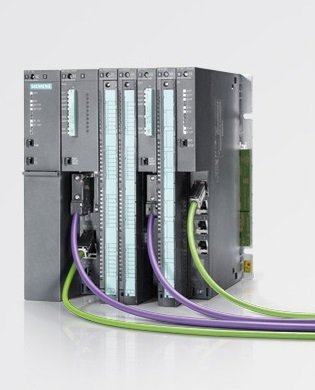Siemens PLC Programming, S7-300 and S7-400 (SIMATIC S5) PLC
Communication Modules

PLC Racks
These racks, where PLC cards are installed, differ according to PLC classes. Within the PLC group, S5-90 and S5-95 are directly mounted on rails and are not mounted on any rack. S5-100 cards are mounted on elements called submodules. Communication is provided with the bus line on these elements.
In addition, these modular elements provide ease of assembly. Submodules are mounted on the rail. Boards belonging to S5-100 type PLC are also mounted by screwing on submodules. Submodules fulfill the tasks of submodules in S5-115 systems. Submodules are not compatible with the rail system and are fixed with screw mounting. These elements have different types according to need.
Some models can only be equipped with input-output cards, while others can also be equipped with various special modules. Fan units can be mounted on the bottom sides of the S5-115 system to cool some cards that can draw high current. It also contains a power supply that supplies the cards used in the PLC. In addition, there are cooling fans in this power supply.
Communication Between PLCs (BUS) System
If a production line consists of stations controlled by more than one processor, these stations must work in harmony with each other. The way to work in harmony is to ensure regular data exchange between the processors that control the stations.
For example; In a system consisting of two stations, the separation process will be made according to the measurement result at the 1st station and the 2nd station.
In order for the part measured on the 1st station to be sent to the 2nd station, the information that the 2nd station is ready must be received by the 1st station. The separation information (thick, normal, thin) obtained as a result of the 2nd station measurement should be received from the 1st station and should be able to send the part to different bands accordingly.
It is unnecessary and uneconomical to draw as many lines (parallel communication) as the number of information to be transmitted between processors. Instead, the information to be sent is sent sequentially by the sending processor over a single line in the framework of the protocol. The receiving processor receives, edits, and uses the information sent with the same protocol. (serial communication).
Processors are not always communicating in this and similar communication systems. Most of the time, it consists of a CPU (master) in the center and its peripheral units (slaves) used to transmit the input and output data from the first different stations to the center. This structure is called the BUS system. S5-155U is the main PLC. Information from other PLCs is compiled in this PLC.
Here a question may arise. It can reach a large number of inputs and outputs in PLC systems. Therefore, should it be used in communication with stations and peripheral units using a large number of CPUs with one CPU per station, or using a single processor? what is plc?
This is primarily a matter of the size of the systems and the interdependence of the stations. First of all, it means controlling different systems with a single CPU, it means locking the systems with each other. That is, a failure of either system or processor will cause the other system or processor to fail. In addition, too long the program means that the cycle time, ie the update time of the inputs and outputs becomes too long. This is also an undesirable situation in programming.
However, using a different processor in each system means the cost of the system increases. Today, there is a BUS system produced by many companies producing in the field of automation. The main features that distinguish these systems from each other are as follows.
- 1. How the data and control lines are connected with each other (topology shape: tree, star, straight line, circle)
- Maximum transmission line length
- .Data transmission rate
- Error-free data transfer
- Maximum number of input and output elements that can be connected
- Compatible with field staff (buyer and working staff) available in the market
- Field staff can be changed while the system is running, etc
In this section, BUS systems used for data exchange,
- MPI
- AS-I
- PROFIBUS network systems will be emphasized.
